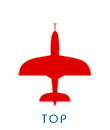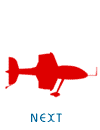
Pilot Aids
Seating Position
Attitude Reference
Pilot Restraint
Side-Stick Controller
Engine/Propeller Control
Instrumentation
Ballistic Recovery System
Precise aerobatic flight requires that the pilot knows his attitude and position at all times, endures minimum work-load, and can control the aircraft precisely while experiencing severe accelerations. For these reasons much attention has been given to the human/machine interface.
Visibility
The location of the pilot in the nose of the airplane, forward of the wing, along with the extensive plexiglass surfaces, offers the pilot visibility that is second to none.
Seating Position
The pilot location allows a reclining seat without significant loss of visibility. This will increase the pilot’s G tolerances. Since the pilot is forward of the aircraft CG, local accelerations due to attitude changes will correctly anticipate subsequent aircraft accelerations, leading to a much smoother ride than conventional configurations.
Attitude Reference
A unique sighting device at the nose of the airplane, at eye level, provides the pilot with precise pitch and roll attitude information. A similar sight is positioned on one wing.
Pilot Restraint
The unparalleled knife-edge capability of this airplane will require devices to restrain the pilot laterally. In particular, adjustable padded structures will provide lateral support for his shoulders and head, while allowing for freedom of movement.
Side-Stick Controller
If a conventional control stick is used, high lateral loads will act on the pilot’s arm, tending to apply aileron. The use of a side stick would help alleviate this problem. Efforts are being made to engineer the controls to be sufficiently light to allow a side-stick to be used. For maximum flexibility in the human interface, there remains the option of installing both a conventional stick and a side stick.
Engine/Propeller Control
To minimize pilot work load, the pilot will have just one power lever at his left hand, which can be split when necessary to control the throttles independently. Immediately forward of the throttles is a key pad for propeller control, with a row of keys for each propeller. For redundancy, the propellers are controlled by completely independent, but networked, microprocessor based pitch control systems. When the propellers are in AUTO mode, the software controls blade pitch to intelligently and efficiently produce thrust as required, or automatically feather a propeller when power is lost due to engine failure or pilot intervention. Other modes are FEATHER, DRAG, and OFF. The DRAG mode activates only when both engines are at idle power, and instructs the software to rotate the blades to a maximum drag pitch setting. In the case of a failure in the control electronics or software, the system is turned OFF and the propeller will automatically feather under aerodynamic and centrifugal loads. The system will be programmed to synchronize the engines under normal operation and avoid any resonant rpm in the drive train.
Instrumentation
In addition to standard instrumentation, an audio variometer will be required to precisely monitor altitude changes in the hover. Angle of attack indicators for both upright and knife-edge flight would be useful and will be driven by sensors mounted on the forward sight mount. Helicopter airspeed indicators will provide accurate low speed instrumentation for both forward and backward flight.
Ballistic Recovery System
Safely exiting Hummingbird during an in-flight emergency would be difficult due to the presence of the duct and propellers immediately behind the cockpit. For this and other reasons, a ballistic recovery system will be standard equipment. A big advantage of this system is its rapid deployment; the entire aircraft can be safely descending under a canopy in less time than it would take the pilot to exit the airplane. A secondary advantage is that complete destruction of the aircraft can be avoided. A system suited to this airplane weighs about 28 lbs.



© Copyright 1992-2009 Philip Carter